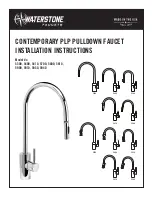
16 1-800-732-0144
WWW.SPORTDOG.COM 17
anotHer poSItIonaL CommanD: SIt
The next command to teach is “Sit.” With this command, you tell your dog to sit and remain seated until it receives
another command. The leash applies pressure to the underside of the dog’s neck when you are training it to sit. You
are now working on a different pressure point. Pull straight up on the lead with your right hand and push down on
your dog’s butt with your left hand until its bottom hits the ground. Add a verbal “Sit” and release the pressure on the
leash. Pressure from the leash can be omitted when your dog is consistently sitting on verbal commands. Later you
will get into corrections and the steps you should follow to make things clear for your dog. Repeat the “Sit” drill until
your dog is happily driving nails with its rear.
Have you ever seen a dog sit sideways? It flops down and comes to rest on one hip. This is a common occurrence for lazy
dogs and needs to be corrected. Pull up on the leash until your dog sits in a proper fashion. It may become necessary to
step forward if your dog will not align itself properly at first. Fight for the proper sit position now and you won’t have to
address this in the future when you are asking it to sit in the face of overwhelming distractions.
Now your dog has learned to come to you, walk comfortably beside you, and sit on command. It must concentrate and
use its brain as it learns these skills. Pay close attention to your dog’s focus, making sure that the training sessions are
not too long. Even though your dog’s brain is a sponge at this point, it can become oversaturated and unable to receive
anymore constructive information.
a foLLoW-Up to “SIt”: Stay
When you give your dog the “Sit” command, you’ve told it to sit and remain seated until it receives another command.
Many obedience programs no longer use the “Stay” command, believing it is redundant and not necessary. However,
it would be good for you to know how to condition for this command if your dog struggles with remaining seated. To
reinforce sitting, apply a light amount of upward leash pressure to its collar and command “Stay” as you start to move
away and toward the end of the leash. Your dog will likely get up and try to move with you. If this occurs, stop it with “No,”
reseat the dog with “Sit,” and repeat “Stay” with another upward tug on the leash. It should not take too many corrections
before your dog figures this puzzle out. Should it continually refuse to stay, add increasing amounts of leash pressure
and stronger “No” commands until it obeys. You may need to be more patient here than any other place. You have already
conditioned your dog to move with you at heel as you move away and many dogs think this is what you want now instead
of remaining seated. Correction for mistakes, rewards for positive responses, and repetition will quickly condition your
dog to this command.
a DIreCtIonaL CommanD: KenneL
You will often require your dog to enter different areas and objects: airline crates, vehicles, buildings, boats, duck blinds,
and fenced areas are just a few examples. You will use the command “Kennel” to tell your dog to enter what is in front of
it. Always use the command “Sit” before you ask a dog to enter. If you give your dog a chance to sit and look into the area
it is being asked to enter, it will be far more likely to perform this skill without a fight. By looking into this area, your dog
can see that the boogie man is not waiting inside.
What should you do if your dog decides it does not want to enter? You know it will give to the pressure of a leash, so
lead it into the proper area and command “Kennel.” Once in the correct place, stroke pup on the shoulder until you
see acceptance via the swallow response. Repeat this routine until you start to develop a conditioned response to your
command. Some dogs fight this entry with a great deal of vigor. If your dog chooses this option, be sure to maintain leash
pressure until you get the desired response. Once it understands that there is no danger in these areas, it will be glad to
enter upon command.
Think about your individual training situation and see if you can create opportunities to work on the “Kennel” command.
This can be accomplished by having an airline crate with you while doing your dog’s obedience routine or working in an
area close to the entrance of your home where the doorway becomes the area in which your dog is commanded to enter.
Or, you could use your vehicle, and this will be very handy when you take your dog to other training areas.
a fInaL oBeDIenCe CommanD: DoWn
The next command in your obedience program will be “Down,” which tells your dog to lie down and remain in this position
until it receives another command. This command is most often used around the home. For this reason, the easiest time
to work on “Down” is at night while watching television. Command your dog to “Sit” and stroke its shoulder when it obeys.
Face the dog, grab its front paws, and pull them toward you. When your dog’s chest hits the floor, command “Down”
and stroke a shoulder again. Most dogs will immediately rise, assuming a sit position. If this occurs, correct your dog
with “No” and repeat the “Down” process again. It generally takes around three evenings before your dog will become
comfortable with this routine. But, do not be worried if it takes your dog three weeks.
400-1659_SD-350_Manual.indd 16-17
4/8/13 9:35 AM

































